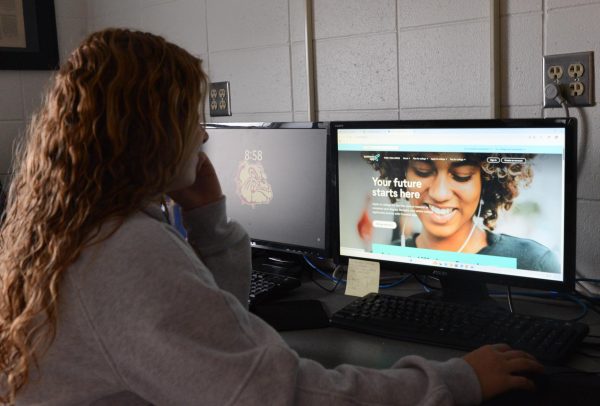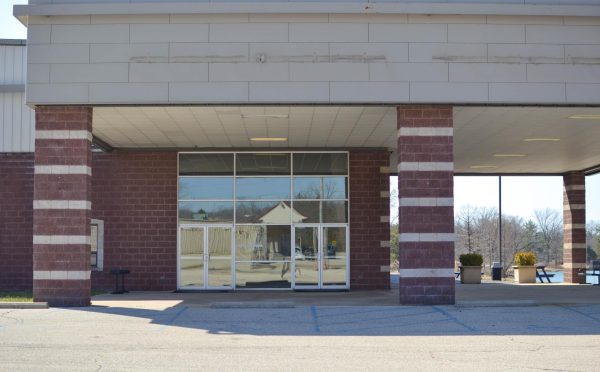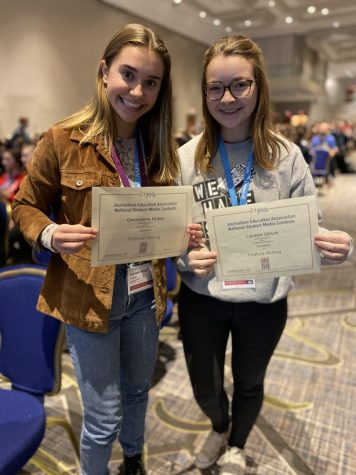Local man discovers cancer biomarker which may lead to early cancer detection
Almost everyone has been touched by cancer in some way. Whether it has affected a family member, friend or taken someone you barely know, cancer is a disease most would never wish on their worst enemy. However, research at Missouri University of Science and Technology has yielded a potential answer to this ruthless killer. Dr. Yinfa Ma, father of senior Kelly Ma, has been working for years on a project that he hopes will change early cancer detection and prevent it from taking thousands of lives.
“Cancer is a very threatening disease. No one wants to hear from the doctor that they have cancer. That’s really the word that nobody wants to hear,” Ma said.
Since immigrating to the United States from China in 1986, Ma has been conducting his own early cancer detection research.
“The major reason I came here from China in 1986 was to get my PhD. Actually, before I came here, I was university faculty already. So really, [I came here] just because I wanted to get a PhD and into a graduate school program. Then in 1990, I went to Truman State University, which was at that time called Northeast Missouri State University. I stayed there eleven years. Then in 2001, I relocated here to join Missouri S&T, called UMR at that time. The major reason I moved down here was because I really wanted to conduct research. Even at Truman, in 1995 and 1996, we had discovered a group of biomolecules which were potential biomarkers for early cancer screening,” Ma said.
The move to Missouri S&T and its research facilities allowed Ma to focus on his goal detecting cancer before it was too late for a patient.
“Cancer is a killing disease. The number one killer in the world is heart disease, but most people die right after a heart attack; they don’t suffer. However, cancer is different. Cancer is just, oh my gosh, I don’t want to use a nasty word to describe it, but it kills you gradually. So I was determined to really find a way to screen and detect cancer early. It’s not easy. There are so many different cancers, different people, different diets, and it makes it really difficult. But I was determined to do it, and it has taken a long time – from 1995 to 2014, [which] is a really long time. But I think we are getting there; in [those] 19 years we have really learned a lot. My goal is to identify a technique and a group of molecules to detect cancer early so people won’t suffer,” Ma said.
With cancer, early detection is extremely essential to save lives.
“Actually, cancer is not a very threatening disease if it can be diagnosed early. If you identify cancer early, when it has not spread, you can just remove it, and you’ll be okay. But the major problem is, when you have a small cancer in the body, you cannot recognize it. You’ll feel normal. Generally, by the time you don’t feel normal, it’s too late. That’s a major problem, and that’s why early cancer screening is so crucial,” Ma said.
While tests like colonoscopies and mammograms exist, they are usually invasive and do not always yield the most accurate results.
“A mammogram is not ideal anyway, because a lot of women still die from breast cancer. The evidence shows that the technique can be improved. The major problem with mammograms is that if the lumps are too small, they are either extremely difficult or impossible to find. Once cancer spreads, it’s really hard to cure it. You can’t just cut out your lungs, liver and kidneys, or else you’ll die anyway. You can’t cut people into pieces,” Ma said.
By developing a machine that detects the natural biomarkers of cancer in urine, Ma has created a technique of cancer screening that is easy, cost effective and revolutionary.
“There is no other instrument like it available. We call it the P-Scan, because it has a double meaning. It’s really good design, really good research and extremely novel. For me to build it, it cost about $50,000 to $60,000, which is relatively cheap,” Ma said.
Though the details of the system are quite advanced for someone not thoroughly educated in the field, it basically works by passing a high voltage across a small capillary, causing the chemicals to migrate. A laser is used to fluoresce these chemicals as they pass through. A detector reports back to a computer where the biomarkers can be compared with those from healthy and afflicted individuals.
“You’re probably asking why we use urine. The reason is, and you probably don’t realize it, because a whole lot of people in the world are afraid of drawing blood. Urine is extremely easy to collect,” Ma said.
Though this technology has already produced some promising results, it is still not ready to be used commercially yet.
“We have to pass a validation process. I don’t want to have false positive or false negative results. I don’t want to tell the person who doesn’t have cancer that they have it, or a person with cancer that they don’t. We’ll try to get past the validation stage as soon as possible. We need a higher population of data to confirm the biomarkers and get a better idea of their accuracy. Until we get enough data, I can’t give you a date. But I’d like to see it in hospitals in the next two years,” Ma said.
However, if approved for use, this simple-looking machine will possibly be able to screen for many types of cancer quickly, painlessly and cheaply.
“Early screening techniques like this one can be integrated into a routine check up, and then if the doctor finds something wrong, the patient will be sent to a specialist to investigate. It’s a warning process. I guarantee it’s not going to be 100 percent accurate; no technique is. But it’s a step forward that may be extremely helpful in a few years. It’s a cool process, but it’s very tough,” Ma said.
Ultimately, Ma’s goal is to save lives by detecting cancer early and putting an end to their suffering before it even begins.
“What we want to do is see if we can help people not die from cancer, and not suffer, that’s my goal. Try to help the people, that’s why I’m here. We have developed a lot of techniques and also identified groups of molecules that can help us. We hope that we can get our work out and help people in the future,” Ma said.
How the P Scan Works
The P-Scan, the early cancer detection instrument with a double entendre, scans urine samples for a type of biomarkers. A biomarker is defined by Merriam Webster as “a distinctive biological or biologically derived indicator of a process, event, or condition.” These biomarkers, known as pteridines, have been linked to a number of malignancies including prostate, breast, bladder and lung cancers. Dr. Ma and his graduate student, Casey Burton, are currently validating these biomarkers in benign and aggressive breast cancers to better understand their usefulness as early breast cancer biomarkers.
The process begins with a capillary, a hollow wire that is thinner than a human hair, and the urine sample that can contain the biomarkers the P-Scan is looking for.
So we have these pteridines that carry a charge when dissolved and a high voltage applied across the capillary. The result is migration of the pteridines through the capillary,” Burton said.
Each pteridine has different properties and move at different rates. These differences help them be recognized and evaluated.
From there, things start to get a little colorful.
“This laser is a very specific wavelength…so these pteridines, when you hit them with light of a particular wavelength, they fluoresce. These guys light up when you hit them with light of a very specific wavelength [of light],” Burton said. “We then use a detector that transmits that absorbance to any electrical voltage which then can be fed into the computer.”
Many biomarkers fluoresce, or light up, when hit with certain types of light. Once the biomarker lights up, that information is sent to the computer where sense can be made of it.
“What happens then is we have a time plot vs. voltz and as those compounds come out, as they actually pass through the little window in the capillary, we see a very sharp peak which is very representative of this sort of technique. With that peak, we can then calculate the area underneath and have an idea of how to compare normal vs. aggressive cancers,” Burton said.
The findings are what led Burton and Ma to suggest that the P-Scan could be useful in detecting early signs of breast cancer. It’s what led to the possibility of catching cancer early, and potentially saving lives.











